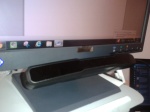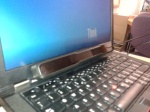I’ve been developing a minor obsession with spell-checking software lately. This arose from noting that the spell-checking in Google Drive (previously called Google Docs) was pretty good and seemed to give decent results. These results were also reached without the need for two separate checks – spelling and homophones. The reason for these results and dispensing with the homophone check is that Google Drive analyses the spelling errors in context of the sentence. The more commonly used spellcheckers seem to analyse each error individually. The other power that Google Drive has is a database of all the spelling errors made by everyone who has ever typed in a Google search. Continue reading
Category Archives: fil
Interesting Technology from BETT 2014
For those unfamiliar with BETT, it is the largest educational technology exhibition in Europe. Taking place annually in London, there are over 600 exhibitors including massive companies such as Google, Dell, Intel and Microsoft. The interesting stuff, from an Additional Support for Learning perspective, is generally on the smaller exhibition stands, though there is plenty from the larger manufacturers which may be suitable for those with Additional Support Needs.
I’ve summarised my highlights below. For summary of my tweets during the event, including pictures go to: http://storify.com/FilMcIntyre/fil-s-bett-2014
Tablets
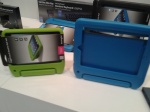 There were multiple stands showing many different iPad cases, but this one caught my attention. Kensington have a rubbery case called a SafeGrip which surrounds the iPad, but also has a handle. Great for students who struggle with carrying equipment. http://bit.ly/safegrip
There were multiple stands showing many different iPad cases, but this one caught my attention. Kensington have a rubbery case called a SafeGrip which surrounds the iPad, but also has a handle. Great for students who struggle with carrying equipment. http://bit.ly/safegrip
Tech21 make cases from a polymer which adjusts to pressure so should create better resistance to being dropped. They have a range of cases, but more significantly screen covers which protect against impact to the screen (the most vulnerable part of any tablet). https://www.tech21.com/
Intel was showing a ruggedized Windows tablet – The StudyBook- which should stand up to a fair amount of abuse. Significantly the screen was protected. The person on the stand took great delight in repeatedly dropping a large ball- bearing onto the screen. See a video here
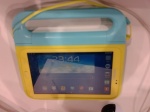 Rather than rely on a case to supply a handle, Samsung have produced a version of their Tab 3, 7 inch Android tablet for education which has a handle built in. The disadvantage? It is bright yellow and blue. http://bit.ly/samsungeducation
Rather than rely on a case to supply a handle, Samsung have produced a version of their Tab 3, 7 inch Android tablet for education which has a handle built in. The disadvantage? It is bright yellow and blue. http://bit.ly/samsungeducation
Software
There are currently two pieces of software designed to support emergent eye-gaze users (Eye-FX and Look to Learn). Inclusive technology were showing previews of their software package – Inclusive Eye Gaze Learning Curve – which comes out later in the year. The first title focusses on Attention and Looking and provides a progression of engaging activities to assess and develop eye-gaze users. http://www.inclusive.co.uk/inclusive-eye-gaze-p6501
Audio Notetaker is a great piece of software from Sonocent. They have now released a version for iOS (iPad/Phone etc.). Called “Recorder” it enables students to record live audio of a lecture and mark the important points as they go along. The result can later be uploaded to the full version of Audio Notetaker for further revision and linking to PowerPoint slides or images. http://www.sonocent.com/en/the_software/recorder/
Other

Since production of the Flip video camera ceased I’ve been looking for an alternative which is as easy to use, but not expensive. TTS have produced one which seems to fit the bill. It feels a bit plasticy, but is simple to use and has a built in USB plug to transfer the content. It also has a 4GB SD card and HDMI output. http://bit.ly/ttscam
Beamz is a very unusual and accessible way to play music. For students who are unable to hold or play a standard instruments, Beamz provides 4 laser beams which, when broken by a hand or object, will trigger sounds from an attached computer. http://thebeamz.com/
Fil McIntyre
Assistive Technologist, The BRITE Initiative
MyGaze Eye Gaze Device
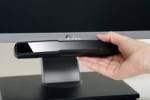 Note: this article assumes some previous knowledge of eye gaze technology.
Note: this article assumes some previous knowledge of eye gaze technology.
For the last couple of weeks I’ve been borrowing a MyGaze device from Visual Interaction a German company. MyGaze is an eye tracking device similar to devices which have been on the market for a while (Tobii PCEyeGo, Alea IntelliGaze). The big difference? The developer version of MyGaze is currently selling at €499 (about £420).
It must be mentioned at the outset that the MyGaze device has not been developed with Assistive Technology in mind, I was just keen to find out if it could be a more affordable eye gaze solution for PC Access and Communication.
The MyGaze is a fairly compact device, the photos show it attached to a standard monitor and laptop. One big advantage which is immediately apparent is the 1.8 metre USB cable, great if your laptop or tower is a distance from your monitor.
After a quick 5-point calibration the MyGaze seemed to follow my gaze accurately. The MyGaze configuration tool has a “Live Gaze” view which shows the position of your eyes being tracked on screen. After this I thought I’d try some control in the Windows environment. The first hurdle to this was that as standard MyGaze doesn’t force the
cursor to follow your eyes (remember it is a developer tool). To do this I needed to track down the MyGaze Cursor application* which can be downloaded from the MyGaze website.
Once this was all set up I tried some simple Windows control e.g. clicking on things, launching programs etc. I tried this both with using a mouse to click and using dwell click software (Smartbox’s Dwell Clicker 2). MyGaze isn’t really accurate enough to achieve this level of control. The cursor drifts and moves around as you are trying to click and this is means that when using dwell click it is impossible to stay on the target long enough for the click to occur. Tobii’s Windows Control and Gaze Interaction applications are designed to counteract this by zooming in on the target. See notes below about future developments from MyGaze.
My next trial was with three pieces of software designed to be used with eye gaze: Eye-FX, Look to Learn and Tobii Communicator. Both Eye-FX and Look to Learn are designed for new or developing eye gaze users and as such have large targets and easy to access activities. MyGaze worked very effectively with both of these applications. Accuracy wise I didn’t notice any difference to using them with Tobii’s PCEyeGo. A usability difference was not having the annoyance of the Tobii Windows Control toolbar popping out from the edge of the screen every time I looked at it.
When it came to using Communicator software the results were mixed. Communicator has a dwell-click function built in, or there is the option to use a switch to select. When using dwell-click the issue is the same as with controlling Windows: If the target is too small it is not possible to dwell on it for long enough. I was very successful using grids with large cells e.g. 5×4 or 6×4, but this accuracy decreased as the size of cell decreased. Using a keyboard layout was just about manageable with a switch click, but the drift mentioned earlier made it tricky. I’m prepared to accept that this might just be a question of practising more and getting used to this system. I did find I had greater accuracy when using the unit on a standard monitor, rather than mounted below a laptop screen, despite performing a more complex calibration (featuring a set-square) to set up the laptop mounting.
Unfortunately I didn’t have a chance to try the MyGaze with any current eye-gaze users. I wanted to see how well it performed with head movement and with users moving in and out of the track box (the area within which it can still keep a fix on a user’s eyes). The plan is to pass the MyGaze onto Beaumont College and National Star College where they should be able to ask some current eye-gaze users to experiment.
In conclusion, MyGaze is an interesting development in eye gaze technology which may well challenge the current level of pricing in the eye gaze market. The user interface is not as slick as some others and is obviously aimed at developers rather than an end user. If the MyGaze Cursor tool could be integrated into the main configuration, along with keyboard shortcuts to pause the interaction, then I could see uses for it in an Assistive Technology context. Those uses would currently be limited to users who were working at a basic level with large targets or relatively few cells in a communication grid. For fine control in a Windows environment an additional tool will be required, like Tobii’s Gaze Selection software. For control in communication software a company like Smartbox will need to fine-tune The Grid 2 to work with MyGaze (much as they have with the other main eye-gaze technologies).
Mainly due to the interface I won’t currently be recommending MyGaze to end users as an assistive technology solution. However, I’ll be keeping a careful eye on how the MyGaze software develops and whether the price stays at its current level.
*Many thanks to Mick Donegan from Special Effect for his assistance
Visual Interaction provided the following information about future developments of MyGaze:
- we are working with Mick Donegan on an eye mouse based on his recommendation, internally known as ‘Mick’s Mouse’. It will provide all you mention in terms of zooming, smoothing and dwell and expect to have the beta out by Jan. The accuracy problems will be solved completely then by the software.
- some software (like Look to Learn) will be made out of box and solved in our store at v competitive price. Other, like The Grid and Rolltalk will have tailor-made interface developed by us or the original SW developer. This is still in discussion phase regarding time, but so that you know what to expect.
- software for special needs school is also in development.
Tablet accessibility
A presentation on ‘Bring Your Own Accessibility’ by BRITE assistive technologist, Fil McIntyre, earned Highly Commended status for the Hans-Heinrich Bothe Award 2013.
The Hans-Heinrich Bothe Award is given to the author and presenter of the Best Paper at the ENABLE International Conference on Using New Technologies for Inclusive Learning and is voted for by the conference delegates.
If you’d like a flavour of what the delegates at the ENABLE conference rated so highly, pop along to our free 30 minute webinar on Wednesday 9th October at 11:00 BST to hear Fil’s take on tablet accessibility.
Update 10.10.13… a recording of the tablet accessibility webinar is now available in the webinar archive.
ICT and Inclusion Presentations: Part 2
Today, we’re following on from our previous post on ICT and Inclusion 2013 – which summarised BRITE presentations on tablets and accessibility, and easy video captioning.
Here, BRITE Training Manager Niall Hardie gives an overview of two more presentations from the event: using what you already have as inclusive learning tools, and tips on effective iPad use for students.
It’s likely that these seminars will feature in our online webinar programme this session so keep a lookout for the details published on the BRITE website, and through our eNews (subscribe via the BRITE homepage).
Using What You Already Have
This session focused on using tools that many people commonly have on them already, or that are easily and freely available online. A key example of that is the ubiquitous Smart Phone. The way the mobile phone market has developed, it will soon be hard to purchase a phone that is not categorised as a smart phone, and these phones often come with capabilities that can be effectively used to assist study and work.
Smart phones can be used as a digital recorder to capture key points in lectures, or to record an immediate verbal summary of a completed class. The built-in cameras can be used to capture information on boards, in books, examples of practical work, and so on – they can also be used to video processes and demonstrations. There are also a wide variety of apps that can be explored – certainly too many to do justice to in a short blog post!
The other options to explore include using Google Drive for free storage and to make use of the range of online software tools for word processing and other activities – available on any internet connected computer, with the added help of Google’s very effective spellchecker. Finally, other powerful tools to explore are Evernote (for collating notes, research and ideas) and Evernote Clearly – a tool that enables you to read the main text on a webpage without the peripheral visual noise of adverts, banners and links.
Effective iPad Use for Students
This seminar looked at the key tasks that most students need to undertake, and considered how the iPad might make that more effective and more efficient. Here is a concise list of some ideas – but be aware that there are hundreds of thousands of apps out there, so this is a list of ideas that I know work, but there will be others that can do a similar job.
- Reading: iBooks; Safari Reader; Instapaper; Kindle – and utilise the built-in voice to speech option
- Writing: Pages – and consider using an external keyboard and monitor for extended writing
- Notetaking: Evernote; Notability – and make use of the camera for pictures and video
- Research: Instant on and access to wifi; dependent on good institutional use of wifi and online resources
- Mind Mapping: Inspiration; iThoughtsHD
- Organisation: 2Do; Calendar
- Communicating/Collaborating: FaceTime; iMessage; email
Do you have a favourite iPad app of particular use to students? Let us know in the comments!
ICT and Inclusion Presentations
 For the third year running, BRITE partnered with CALL Scotland to deliver ICT and Inclusion: Two days of seminars and exhibition targeted at people working to include learners with additional support needs. Niall Hardie and Fil McIntyre from BRITE were both presenting semimars on technology which may assist learners. With twenty exhibitors and twenty eight seminars, the days were pretty full and some people were unable to get to hear Niall and Fil. A summary of Fil’s seminars is below, with Niall’s to follow shortly.
For the third year running, BRITE partnered with CALL Scotland to deliver ICT and Inclusion: Two days of seminars and exhibition targeted at people working to include learners with additional support needs. Niall Hardie and Fil McIntyre from BRITE were both presenting semimars on technology which may assist learners. With twenty exhibitors and twenty eight seminars, the days were pretty full and some people were unable to get to hear Niall and Fil. A summary of Fil’s seminars is below, with Niall’s to follow shortly.
Tablets and Accessibility: iPad vs. Android vs. Windows
This session featured a brief run through of the accessibility options on the three main tablet operating systems. iOS (on the iPad) came out strongest by far with a wide range of visual and cognitive support options (and more to come in iOS7), but this is not to dismiss Android and Windows. Fil was keen to point out that users’ accessibility may be down to the size or format of the tablet. In this case Android offers a much wider choice due to the amount of manufacturers providing Android tablets.
For Windows 8 tablets the accessibility options are very similar to a desktop PC, but (for example) provide a much wider range of high contrast display settings when compared to iOS’s normal or negative option. Also the fact that a Windows 8 tablet can run full versions of Windows software may open it up as a possibility for users who cannot find an app equivalent to their access software.
BRITE can provide half-day seminars on the subject of tablet useage. Two examples are “Tablet Tools” and “Bring Your Own Accessibility”.
Getting Captions Onto Your Video the Easy Way
Captioned videos can assist not only deaf students, but also those for whom English is a second language. It is generally time consuming and expensive to get the captions onto videos. In this session Fil showed how to easily synchronise a transcript to your video by uploading both the transcript and the video to Youtube. Youtube’s voice recognition will ensure the correct text is shown at the time it is spoken.
For further practical details on how to do this see this earlier post on the BRITE blog.
Which is the Best Spell Checking Software?

One of the primary tasks someone with literacy difficulties or dyslexia wants their software to do is check their spelling. So you might expect that, as an Assistive Technologist, I get asked the question “Which is the best spell checking software?” a lot. However, despite the prevalence of students with literacy difficulties and the many software titles which claim to assist them, I very rarely get asked this question. I suspect this is because people assume it will be one of the dominant software titles such as Read&Write or ClaroRead.
If someone was to ask me now the answer wouldn’t be a piece of software, it would be a cloud service. And the answer is: Google Docs.
One key way Android is more accessible than iOS

 It would be an understatement to say there has been a fair amount of fuss over the release of the Google Nexus 7 tablet.
It would be an understatement to say there has been a fair amount of fuss over the release of the Google Nexus 7 tablet.
As an Assistive Technologist my focus is always on the accessibility of devices and how they cater for users who may access them in a non-standard way.
The accessibility tools built into Apple’s iOS give it a clear lead over Android in this area. Android is catching up but if you are visually impaired or require assistance with selecting items on the screen iOS is likely to be the preferred choice.
The release of the Nexus 7 has brought into focus Android’s key accessibility advantage which is: Choice of Platform. For anyone with a physical disability size and weight can be the crucial influence on tablet choice. iOS is currently available on three platforms: iPod Touch, iPhone and iPad giving only two screen size choices (3.5 and 9.7 inches) and three weight choices (101g, 140g and approx 650g dependent on iPad model). The rumours about a new smaller iPad may give a further choice of screen size and weight.
A quick examination of the Android device comparison page on Wikipedia shows a wide range of device sizes and weights. The i’m Watch is the smallest, smartphones range from 2.8 inches and 105 grams to 5.3 inches and 178 grams, tablets are mostly 10.1 inches but there are many at 7 and 8 inches and a range of other sizes. There are also devices with built-in or detachable keyboards and touchpads for those who need/want their tablet to work like a laptop.
The fact that Android is available across multiple devices is often cited as one of its weaknesses. For those who are concerned with size and weight of a device it could be Android’s greatest strength.
Fil McIntyre
Assistive Technologist
BRITE
Evernote Optical Character Recognition

I use Evernote to help organise my work and personal life. It is a very simple app and makes it easy to synchronise notes between my iPad, smartphone and home and work PCs.
There is a useful hidden extra which I have only recently become aware of: Evernote will perform Optical Character Recognition (OCR) on your photos. Evernote enables you to take a photograph as a note and then categorise it or tag it as you would with a typed note. Once your photo is uploaded to the Evernote server it will perform OCR and therefore allow you to search for any text contained in that note. You can do the same with a photo imported from you photo library.
This could be really useful for people with literacy or memory difficulties who record information using photographs. Rather than having to visually scan through all their photographs to find the one they need, they can simply type a key word and Evernote will find that photo for them and highlight the searched for word.
The amount of time it takes is variable, seemingly dependent on the busyness of Evernote’s servers. I have had one note take minutes while another took 24 hours. If you upgrade to Evernote Premium (£3.99 per month) the images get processed faster.
The accuracy of the OCR is quite good. I’ve tried photos of standard and faded, printed text as well as a photo of the front of my car stereo and it seems to pick up most things. The only text it struggled with was when two names in a list of phone numbers were separated by a / with no space in between. Evernote did not pick up the individual names. This may seem an obvious statement but it will not work with handwritten notes either. EDIT: Evernote’s technology can perform OCR on handwriting but as they say “The clearer the handwriting, the more likely it will be accurately indexed for search. If the penmanship is difficult to read, then Evernote will have a much harder time discerning the written words.”
Evernote is available on iOS (iPhone/iPad), Android, Blackberry and Windows Phone 7 so most smartphone users should be able to download the app. It can also be installed on PC and Mac so that notes can be used away from the smartphone.
Fil McIntyre
Assistive Technologist
Using the iPad with a screenreader
 As part of Global Accessibility Awareness Day I’ve just spent 1 hour using my iPad with VoiceOver, the in-built screenreader. I have some limited experience of using screenreaders, but being sighted have never used one for for an extended period of time. I have used them on PCs, but was especially interested to see how they worked on a touchscreen device.
As part of Global Accessibility Awareness Day I’ve just spent 1 hour using my iPad with VoiceOver, the in-built screenreader. I have some limited experience of using screenreaders, but being sighted have never used one for for an extended period of time. I have used them on PCs, but was especially interested to see how they worked on a touchscreen device.
I spent what can only be described as a very frustrating hour and now have an even greater respect for screenreader users.
I was attempting to continue with my normal work but several problems prevented me from performing straighforward tasks. I’m not saying these are problems with VoiceOver on the iPad as it gets good reviews from blind users. I share them to illustrate how tricky it could be for a blind user to access a device such as the iPad with no previous experience.
So that I couldn’t cheat I also turned on the screen curtain which turns the whole of the iPad’s screen pen black.
